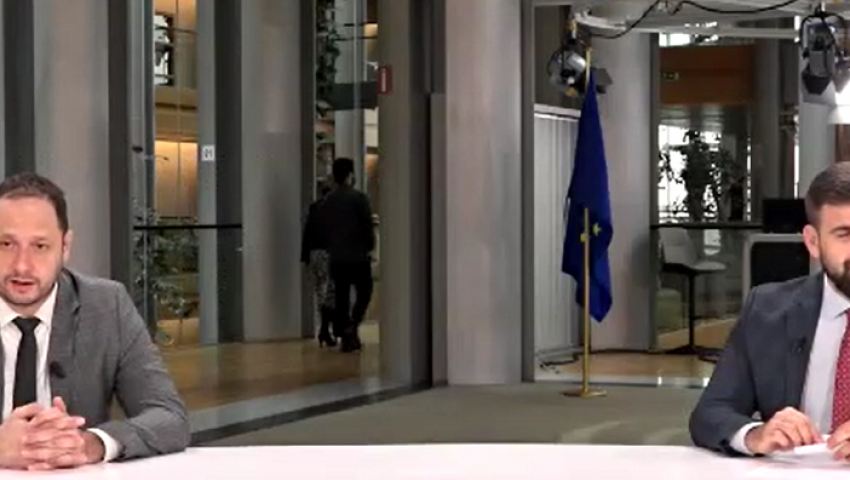The ban on cars with internal combustion will accelerate the decline in the prices of electric cars, believes MEP Petar Vitanov
Bulgaria will continue to be a graveyard for old cars, and anyone who wants to will be able to continue driving their old diesel car from 2035

Press conference of the EP and MEPs Petar Vitanov S&D (right) and Andrey Novakov, EPP for the EP plenary session: REpowerEU and standards for CO2 emissions from cars and vans
Photo: Prt Screen Zoom
Raya Lecheva
The ban on internal combustion cars will lead to a sharp drop in the prices of electric cars, commented MEP Petar Vitanov from the group of Socialists and Democrats in the European Parliament from the BSP quota during a briefing. This is one of the reasons why, as part of the Socialist group in the European Parliament, I support this new legislation. This will happen because of economies of scale and improving battery technology and using available raw materials that have been diverted because of the war, and it will happen more slowly, but it will still happen, Vitanov said.
It is expected that by 2026 the prices of electric cars will equal those of internal combustion cars. This will still have a good effect on Bulgaria as the poorest country in the EU, it is clear that it is still difficult to afford electric cars. But still, the changes will lead to the creation of a used car market and a second-hand market more quickly. We will not prevent the situation of continuing to be a tomb for diesel cars, but no one will prohibit us from continuing to buy them after 2035. Anyone who wants to will continue to drive their old car.
22 Member States already support the purchase of electric cars,
in Romania, the old ones are bought for 1800 euros
In the EU, 22 countries already apply measures to stimulate the use of newer cars or electric cars. In neighboring Romania, their best-known brand Dacia together with the state organized a campaign to buy back old cars for 1,800 euros and allocate 10,000 euros for a new one, with the brand's electric cars selling for around 22,000 euros.
In fact, 30% of emissions are due to the transport sector and 20% to land transport and so far no successful measures have been applied to reduce emissions from it as the only opportunity lies in the electrification of cars and light trucks, while waiting for the technologies for their recycling to keep getting better. But leading in limiting the use of cars with internal combustion engines should be the fact that we continue to lead Europe in terms of mortality, with the average Bulgarian dying 2 years earlier due to diseases related to the effects of the dirty air we breathe. Electric cars pollute 30% less throughout their life cycle, statistics show, Vitanov pointed out.
What the EU's path to zero emissions envisages
Parliament today approved new targets for reducing CO2 emissions from new passenger cars and light commercial vehicles as part of the Target 55 package. With 340 votes in favor, 279 votes against and 21 abstentions, MEPs approved the agreement reached on revised CO2 emission standards for new cars and vans.
The new legislation sets the path to zero CO2 emissions from new passenger cars and light commercial vehicles by 2035 (a target for the entire EU fleet to reduce the CO2 emissions produced by new cars and vans by 100% compared to with 2021). The interim emission reduction targets for 2030 are set at 55% for cars and 50% for vans.
By 2025, the Commission will present a methodology for assessing and reporting life-cycle CO2 emissions data for cars and vans sold on the EU market, accompanied by legislative proposals.
By December 2026, the Commission will monitor the gap between emission standards and real-world fuel and energy consumption data, report on a methodology for correcting manufacturers' specific CO2 emissions and propose appropriate follow-up measures
Manufacturers who have small production volumes per calendar year (1,000 to 10,000 new cars or 1,000 to 22,000 new minibuses) can obtain a derogation until the end of 2035 (those registering fewer than 1,000 new vehicles per year, remain exempt).
To meet expected sales trends, the current zero and low emission vehicle (ZLEV) incentive mechanism, which encourages manufacturers to sell more such vehicles (with emissions of zero to 50g CO2/km, such as electric vehicles and well-functioning hybrids) with lower CO2 reduction targets will be adapted to
From 2025 to 2029 the ZELEV target benchmark is set at 25% for new car sales and 17% for new vans, with the incentive removed from 2030; Every two years from the end of 2025, the Commission will publish a report assessing progress towards zero-emission road mobility.
Rapporteur Jan Hoytema (Renew, Netherlands) said: "This regulation promotes the production of zero- and low-emission vehicles. It contains an ambitious revision of the 2030 targets and a zero-emissions target for 2035, which is critical to achieving climate neutrality by 2050. These targets provide clarity for the automotive industry and drive innovation and investment by car manufacturers. Buying and driving zero-emission cars will become cheaper for consumers and the second-hand market will be created faster. This makes sustainable driving accessible to everyone."
After the final vote in plenary, the text will have to be formally approved by the Council as well, shortly after which it will be published in the EU's Official Journal.
On 14 July 2021, as part of the Ready for Target 55 package, the Commission presented a legislative proposal to revise the CO2 emission standards of new passenger cars and light commercial vehicles. The proposal aims to contribute to the EU's 2030 and 2050 climate goals, deliver benefits for citizens and stimulate innovative zero-emission technologies.
